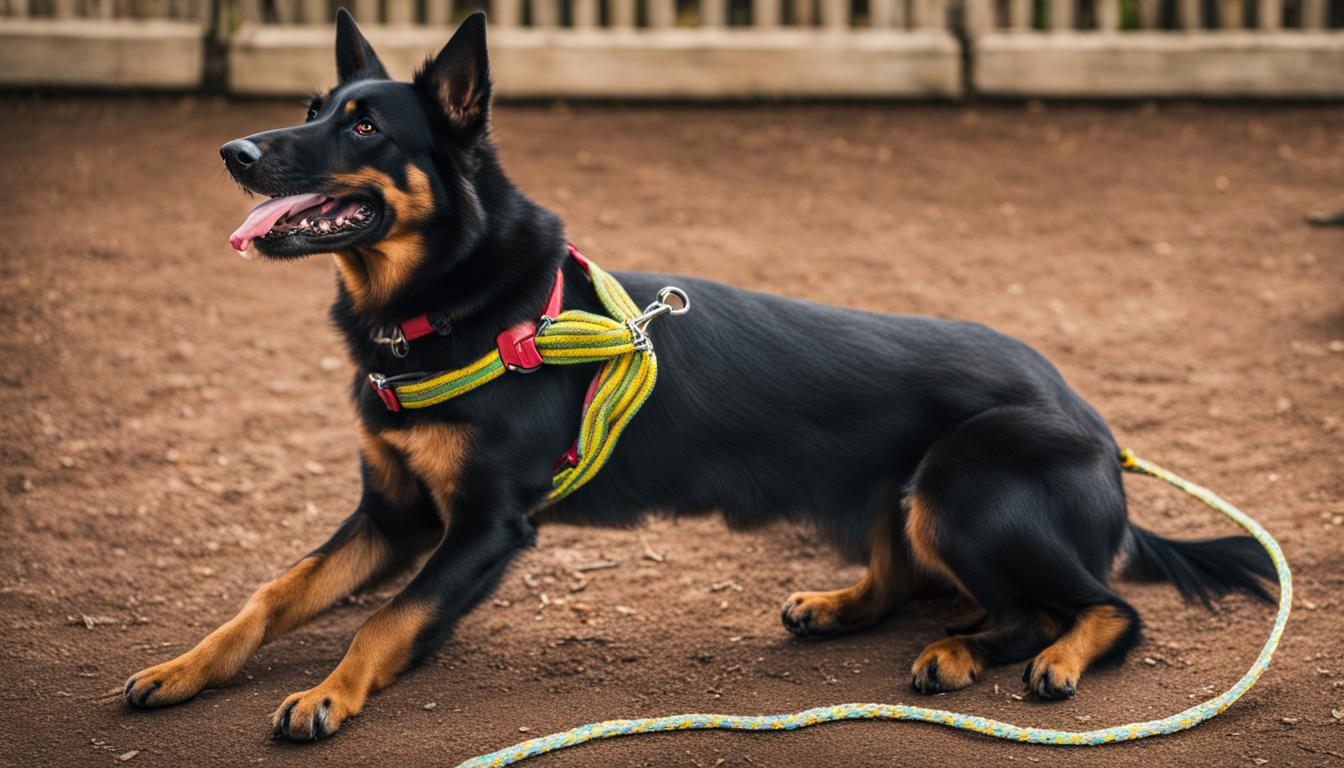Welcome to our comprehensive guide on maintaining consistency in dog training. Consistency is the key to achieving effective results and ensuring a well-behaved and obedient furry companion. By establishing consistent training schedules, routines, and methods, you can develop a clear and reliable communication system with your dog, leading to a happier and more obedient pet. In this article, we will provide you with valuable strategies and tips for maintaining consistency in dog training, helping you unleash the full potential of your furry friend.
Key Takeaways:
- Consistency is crucial in dog training to achieve effective results.
- Establish consistent training schedules and routines to reinforce desired behaviors.
- Maintain consistency in commands, cues, rewards, and reactions for clear communication.
- Understanding the importance of consistency helps dogs learn and exhibit desired behaviors consistently.
- Consistency in training methods creates a solid foundation for effective dog training.
Understanding the Importance of Consistency in Dog Training
Dogs are highly responsive to consistency in their training routines. Establishing a consistent training schedule and reinforcing consistent behaviors can have a significant impact on their overall behavior and obedience. When dogs are trained consistently, they develop a clear understanding of the commands and cues given to them. This understanding helps them to consistently exhibit the desired behaviors.
Consistency in training also helps to avoid confusion and frustration in dogs. When training methods are inconsistent, dogs may struggle to understand what is expected of them, leading to unreliable obedience and behavioral issues. By providing clear and consistent guidance, dog owners can create a reliable communication system with their pets, enhancing the effectiveness of their training efforts.
“Consistency is crucial in dog training as it helps dogs understand what is expected of them.”
Additionally, consistency in training can help dogs to form positive associations with their behaviors. When dogs receive consistent rewards and positive reinforcement for exhibiting the desired behaviors, they are motivated to repeat those behaviors consistently. This reinforcement strengthens the bond between dogs and their owners and increases the likelihood of continued obedience.
It is important for dog owners to understand the behavioral impact of consistent training. By establishing clear routines, using consistent commands and cues, and providing regular positive reinforcement, dog owners can create an environment conducive to learning and consistent behavior. With consistency, dogs can thrive and become well-trained, obedient companions.
| Benefits of Consistent Training | Impact on Dog Behavior |
|---|---|
| Improved obedience | Dogs develop a clear understanding of commands and cues |
| Enhanced bond between dog and owner | Positive reinforcement strengthens the bond |
| Reduced behavioral issues | Avoidance of confusion and frustration |
| Increased reliability in desired behaviors | Consistent training reinforces desired behaviors |
“Consistency in training helps dogs form positive associations with their behaviors.”

Quotes:
“Consistency is key in dog training. When dogs are trained consistently, they develop a clear understanding of the commands and cues given to them.”
Importance of a Routine:
- Establishing a routine helps dogs know what to expect, creating a sense of security and confidence.
- Routines provide structure and consistency, making it easier for dogs to learn and remember behaviors.
- A consistent routine reduces stress and anxiety in dogs by providing predictability in their daily lives.
By recognizing the importance of consistency in dog training and implementing these strategies, dog owners can create a harmonious and well-trained pet. Consistency not only helps dogs understand expectations but also strengthens the bond between owner and pet. So, start incorporating consistent training routines today and witness the positive impact it has on your furry friend!
Establishing Consistent Training Methods
When it comes to dog training, finding the right balance between consistency and flexibility is crucial. Consistency ensures that you are using the same commands, cues, and reward systems, while flexibility allows for adapting to different environments and situations. By building consistent training habits, you can create a solid foundation for effective dog training.
To establish consistent training methods, start by selecting a training approach that works for you and your dog. Whether it’s positive reinforcement, clicker training, or another technique, choose one that aligns with your training goals and values. Once you have chosen a method, stick to it and avoid constantly changing your approach. This will help your dog understand what is expected of them and reinforce desired behaviors consistently.
Overcoming inconsistency in dog training can be challenging, but it is not impossible. One way to overcome inconsistency is to establish a training schedule and stick to it as closely as possible. Consistent training sessions provide structure and allow for repetition and reinforcement of learned behaviors. Additionally, setting realistic expectations and seeking professional guidance when needed can help you overcome any challenges you may encounter in your training journey.
Building Consistent Training Habits
Building consistent training habits is crucial for effective dog training. Here are a few tips to help you establish and maintain consistency:
- Create a training schedule: Set aside specific times each day for training sessions. Consistency in the timing of these sessions will help your dog understand when to expect training and make it easier for them to focus.
- Use consistent commands and cues: Use the same words and gestures to communicate with your dog. This will help them understand what you want from them and reinforce consistent behavior.
- Be consistent with rewards: Make sure you’re using the same types of rewards consistently. Whether it’s treats, praise, or playtime, using a consistent reward system will reinforce desired behaviors.
- Stay patient and persistent: Consistency takes time and effort. Be patient with your dog and stay persistent in your training efforts. Consistency will pay off in the end.
By following these tips and incorporating consistency into your training methods, you can establish a strong and effective training routine for your furry friend.
| Consistency vs. Flexibility | Benefits |
|---|---|
| Consistency |
|
| Flexibility |
|
Consistent Reward Strategies in Dog Training
When it comes to dog training, consistent reward strategies play a crucial role in reinforcing desired behaviors. Dogs respond well to positive reinforcement, and consistent rewards serve as motivation for them to consistently exhibit the behaviors you want to reinforce. To ensure effective dog training, it’s important to establish a reward system that is consistent in timing, type of reward, and delivery method.
Consistency in timing means providing the reward immediately after the desired behavior is exhibited. This helps dogs make the connection between their actions and the reward. Whether it’s a treat, praise, or playtime, the reward should be given consistently to reinforce the desired behavior. Additionally, using a consistent type of reward helps to solidify the association between the behavior and the reward. This consistency allows dogs to understand what they can expect as a reward for their actions.
Delivery method is another important aspect of consistent reward strategies. Dogs thrive on routine and predictability, so it’s important to deliver the reward in the same way each time. Whether you use a clicker, a verbal cue, or a simple “good boy/girl,” consistency in the delivery method helps dogs understand that they have successfully performed the desired behavior.
By implementing consistent reward strategies in your dog training, you can create a clear and reliable system of communication with your pet. This consistency reinforces the association between the desired behavior and the reward, encouraging dogs to repeat the behavior consistently. Remember, training takes time and patience, but with consistent rewards, you can achieve long-lasting and reliable obedience from your furry friend.
| Consistent Reward Strategies | Benefits |
|---|---|
| Timing | Helps dogs make the connection between behavior and reward. |
| Type of Reward | Solidifies the association between behavior and reward. |
| Delivery Method | Creates routine and predictability for dogs. |
Consistency in Training Different Dog Breeds
Training different dog breeds requires a consistent approach, although each breed may have unique characteristics and learning styles. By understanding the specific needs and temperaments of different breeds, you can tailor your training methods while maintaining consistency to achieve the best results.
When training different dog breeds, it is important to adapt your commands, cues, and training techniques to suit their specific traits. For example, some breeds may be more energetic and require more physical exercise, while others may be more sensitive and respond better to positive reinforcement. By taking these factors into consideration and consistently applying appropriate training methods, you can effectively teach different breeds to behave appropriately and respond to commands consistently.
Consistency in training also helps dogs of different breeds develop a clear understanding of expected behaviors. By using consistent cues and commands, dogs can quickly learn what is expected of them and respond accordingly. This creates a reliable communication system between you and your dog, making training more effective and enjoyable for both of you.
While training different dog breeds may present unique challenges, the underlying principle of consistency remains the same. By adapting your training methods to suit the specific needs of each breed and consistently applying them, you can achieve consistent results and build a strong bond with your furry companion.
| Breed | Training Method | Characteristics |
|---|---|---|
| Labrador Retriever | Positive reinforcement | Friendly, energetic, and eager to please |
| German Shepherd | Clicker training | Intelligent, loyal, and protective |
| Poodle | Consistent routines | Highly trainable, intelligent, and adaptable |

When creating a training schedule for your dog, consider your own availability and your dog’s needs. Determine the best times of the day when you can dedicate uninterrupted attention to training. Consistency in the timing of training sessions helps your dog anticipate and prepare for learning opportunities. It also helps establish a routine that makes training sessions easier to remember and follow.
During each training session, set a specific duration that is suitable for your dog’s attention span and energy level. Shorter, focused sessions are often more effective than longer ones. Consistency in the duration of training sessions allows you to maintain your dog’s interest and engagement throughout the session.
The key to successful dog training lies in consistent practice. With a consistent training schedule, you’ll be able to reinforce desired behaviors and establish a strong foundation for your dog’s training journey.
It’s important to note that consistency extends beyond training sessions. Incorporate consistent routines and rules throughout your dog’s daily life. For example, establish consistent feeding times, walking schedules, and sleep routines. This helps your dog understand what is expected of them and reinforces consistent behavior both during and outside of training sessions.
Table: Sample Dog Training Schedule
| Day | Time | Activity |
|---|---|---|
| Monday | 8:00 AM | Basic obedience training |
| Tuesday | 6:00 PM | Leash walking practice |
| Wednesday | 9:30 AM | Agility training |
| Thursday | 7:00 PM | Trick training |
| Friday | 10:00 AM | Off-leash play and socialization |
| Saturday | 11:00 AM | Field training |
| Sunday | 4:00 PM | Relaxation and bonding activities |
Remember, consistency in training schedules fosters a sense of routine and reliability for your dog. It helps them understand the expectations and develop consistent behaviors. By dedicating time and effort to consistent training, you can build a stronger bond with your furry friend and enjoy the benefits of a well-trained and obedient pet.
Overcoming Challenges to Consistency in Dog Training
Consistency is crucial in dog training, but it’s not always easy to maintain. Busy schedules, distractions, and varying environments can all pose challenges to consistent training efforts. However, with the right strategies and mindset, you can overcome these obstacles and ensure consistent training for your furry friend.
One of the key factors in overcoming challenges to consistency is understanding the importance of routine in dog training. Establishing a regular training schedule provides structure and helps reinforce consistent behaviors. By setting aside dedicated time for training sessions, you create a routine that signals to your dog that it’s time to focus and learn.
A common challenge to consistency is finding the right balance between consistency and flexibility. While it’s important to maintain a consistent approach to commands, cues, and training methods, it’s also essential to be adaptable to different environments and situations. This flexibility allows you to continue training even when faced with distractions or changes in your dog’s environment.
Seeking professional guidance can also be beneficial in overcoming challenges to consistency. A professional dog trainer can provide personalized advice and guidance tailored to your specific situation. They can offer insights and techniques to help you address any inconsistencies or challenges you may encounter in your training journey.
Remember, consistency is key in dog training, but it’s normal to face challenges along the way. By understanding the importance of routine, finding the right balance between consistency and flexibility, and seeking professional guidance when needed, you can overcome these challenges and maintain consistent training for your beloved pet.
Conclusion
Consistency is the key to successful dog training. By maintaining consistency in your training methods, schedules, and rewards, you can ensure that your furry friend learns and obeys consistently. Whether you are training a small breed or a large one, consistency applies to all dog breeds.
By committing to consistency, you create a clear communication system with your dog, reinforcing desired behaviors and reducing confusion. Remember to establish a routine that suits both you and your dog, allowing for flexibility when needed. Overcoming challenges is part of the process, so don’t hesitate to seek professional guidance when necessary.
With consistent and effective dog training, you can build a strong bond with your pet and create a harmonious living environment. So, embrace the power of consistency and unlock the full potential of your furry friend. Happy training!
FAQ
Why is consistency important in dog training?
Consistency helps dogs understand what is expected of them and reinforces desired behaviors.
How can I establish consistency in dog training?
Find a training method that works for you and your dog and stick to it, striking a balance between consistency and flexibility.
Why are rewards important in consistent dog training?
Rewards serve as motivation for dogs to exhibit desired behaviors consistently and reinforce the association between behavior and reward.
Do different dog breeds require different approaches to consistent training?
Yes, while the approach may differ, consistency in commands, cues, and training methods is essential for all dog breeds.
How can I establish a consistent training schedule for my dog?
Regular training sessions with consistent timing, frequency, and duration set clear expectations and reinforce consistent behaviors.
What can I do to overcome challenges in maintaining consistency in dog training?
Establish a routine, set realistic expectations, and seek professional guidance when needed to overcome challenges and maintain consistency.





